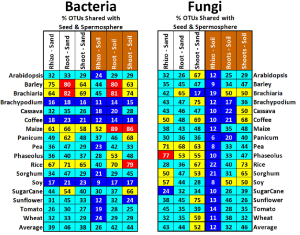A group from MaxPlanck Tandem Group in Plant Microbial Ecology, Universidad del Valle, Cali, Colombia, etc. has reported that the most abundant bacteria and fungi in seedlings rhizobacteria came from their seeds, not the soil.
https://www.frontiersin.org/articles/10.3389/fmicb.2021.737616/full
Until recently, scientists have traditionally believed that all the rhizosphere microbiome “is recruited from the main reservoir of microorganisms present in soil. However, Is it really true?
In this experiment, plants were grown in hermetically sealed jars on sterile sand as a way to observe microbiome development in the absence of any other source of inoculum except seeds. In this experiment, 18 kinds of plant were evaluated.
Amazingly enough, in this experiment it was confirmed that soil contributes to microbial diversity in the rhizosphere, however the most abundant bacteria and fungi in rhizospheres derive from seeds. Soil significantly increased bacterial diversity in rhizospheres, however, the highest read abundance was of seed-transmitted bacteria. Only an average of 26% of bacterial taxonomic units (OTUs) came from seeds, but these were responsible for an average of 72% of the reads. These OTUs were mostly Proteobacteria of the genera Pantoea, Enterobacter, Pseudomonas, and Massilia, which were observed in seeds or spermospheres and have also been observed associated with a variety of plant seeds.
Compared to bacteria, there was less seed-transmitted fungal diversity in rhizospheres, with only an average of 12%; however, these OTUs tended to become abundant, representing an average of 42% of the reads. Of these seed-transmitted rhizospheric fungi, Fusarium was the most abundant, occurring in all soil-grown rhizospheres, as it did in all spermospheres.

In this experiment, unsterilized seeds were planted in either sterile sand or farm soil inside hermetically sealed jars. The sand was sterilized by autoclaving twice for 20 min at 121°C, and after transfer to glass jars, it was autoclaved a third time for 20 min at 121°C, and the soil was excavated from a fallow cassava field at a CIAT property near Palmira, Colombia.
